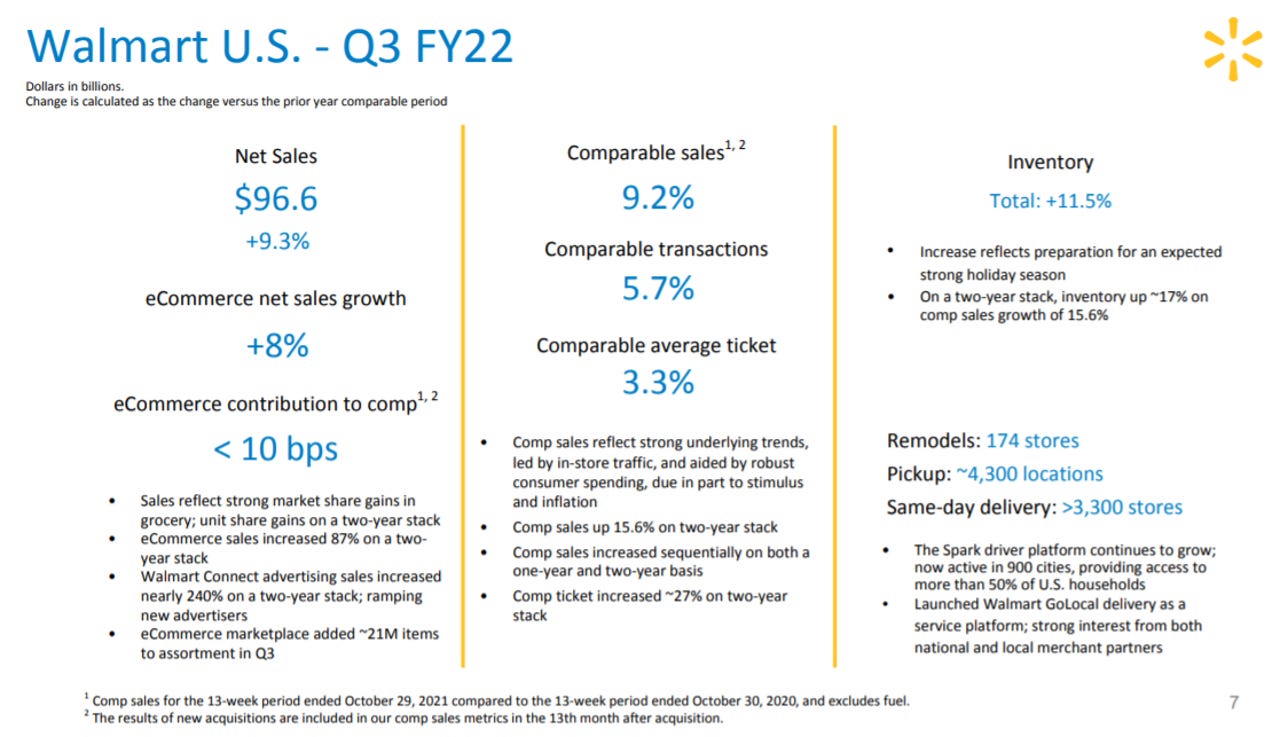How technology and data make Walmart shine amid supply chain issues, inflation

Inflation, supply chain turmoil and a holiday season where consumers will be as worried about inventory as much as price are likely to mean Walmart is going to have a strong fourth quarter. Technology and data will be a big reason why.
Walmart reported third quarter same store sales of 9.2%, earnings of $1.11 a share and revenue of $140.5 billion. Walmart's e-commerce sales grew 8% following massive COVID-19 gains a year ago. The retail giant also upped its outlook for fiscal 2022 and projected adjusted earnings per share of $6.40 compared to its previous guidance of $6.20 a share to $6.35 a share.
It's not surprising that Walmart, a long-time low cost provider, will be popular as inflation in the US spikes. But what may be a surprise is how much Walmart's technology prowess has improved and how the retailer leverages its data stack.
Here's why this is Walmart's moment amid inflation, supply chain issues and consumer demand that's strong but fluid.
Walmart has become a technology company. While Walmart has always been savvy about deploying technology, the COVID-19 pandemic sped up the retailer's digital transformation. Walmart had to innovate on the fly and now is uniquely positioned. Among the key technology developments:
- Walmart GoLocal is the company's white-label last-mile delivery service and Walmart has now signed up The Home Depot as a customer. Spark Driver is Walmart's proprietary driver platform, that will roll out globally. Spark is active in 900 US cities
- Walmart Connect, the retailer's ad network, is gaining momentum and creates a flywheel for suppliers and marketplace sellers. Walmart Connect sales have increased almost 240% on a two-year stack. Walmart also has a partnership with The Trade Desk to expand off-site media offerings.
- Walmart Luminate, a suite of data products, for merchants and suppliers to create actionable category and item insights.
- Walmart Marketplace is now a platform with 160 million items.
Doug McMillon, CEO of Walmart said:
We see tailwinds in our results. A strong consumer, a degree of inflation and government stimulus are all factors, but I also like what I see in the core of the business. Transaction counts in our stores and clubs are growing. Inventory is up 11.5%. Our price gaps are where we want them. And we're innovating in the supply chain and adding capacity. And we're building businesses like Walmart GoLocal, Walmart Connect, Walmart Luminate, Walmart+, Spark Delivery, our Marketplace and Walmart Fulfillment Services.
Walmart has retooled its approach to be digital first and omnichannel. McMillon outlined how Walmart has adopted an approach that revolves around designing omnichannel outcomes.
He said:
We use a phrase here that's called 4-in-a-box which is an agile way of working with customer, product, design, technology, engineering, all around the table, designing omnichannel outcomes for customers and members.
Historically, if you look back years ago, the company would have operated in specialized silos, merchandising, operations, finance, logistics, et cetera. And the teams learned in recent years and is still learning how to move faster, begin with the end in mind, design with that outcome. And that enables us to put technology to work in a way that is truly omnichannel, not siloed.
Walmart has better models to predict how customers will react to inflation. McMillon noted that "fighting inflation is in our DNA" and that the company's models and algorithms have been able to navigate supply chain woes, inventory needs and how consumers may react. Why? Walmart operates globally including a few regions where inflation has been far worse than what the US is currently seeing. Those data points can inform how consumers will react.
McMillon said the inflation pressure is on costs more than retail, which is the way Walmart likes it. The company can manage product mix, flexibility in the supply chain and price gaps to manage the bottom line for customers and the company.
"We haven't seen this kind of inflation in the U.S. for quite some time. But we have operated in markets where we've seen this basically forever and even more extreme. So that experience is helpful," he said.
Walmart is able to leverage its data from its marketplace, supply chain and other services. The end result is that the real benefit to Walmart is the data generated from its assortment and retail operations.
John Furner, CEO and President of Walmart US, said:
One example is we're managing our backrooms of supercenters and neighboring markets around the country, using computer vision and augmented reality to not only know what's in the backroom, but what can be moved to the floor. And we use AR, augmented reality, as a way for associates to know how to direct work. And from that, we generate literally billions of pieces of data every week, and it's helping us with overall inventory management. And I think our in-stock positions reflect that work as an example.
McMillon added that Walmart's data stack is the base of its machine learning and artificial intelligence strategy. McMillon added:
We're using ML and AI to do a number of different things. We used it to help adjust to the pandemic and use the stores as fulfillment hubs. And we use it for predictive baskets, smart substitutions. Our in-stock assistant is AI empowered. We've moved 153 petabytes of data to the cloud so far. And we've got room to grow there. And we can put data and machines to work in ways in this company that we've not yet done, but we are making progress.
